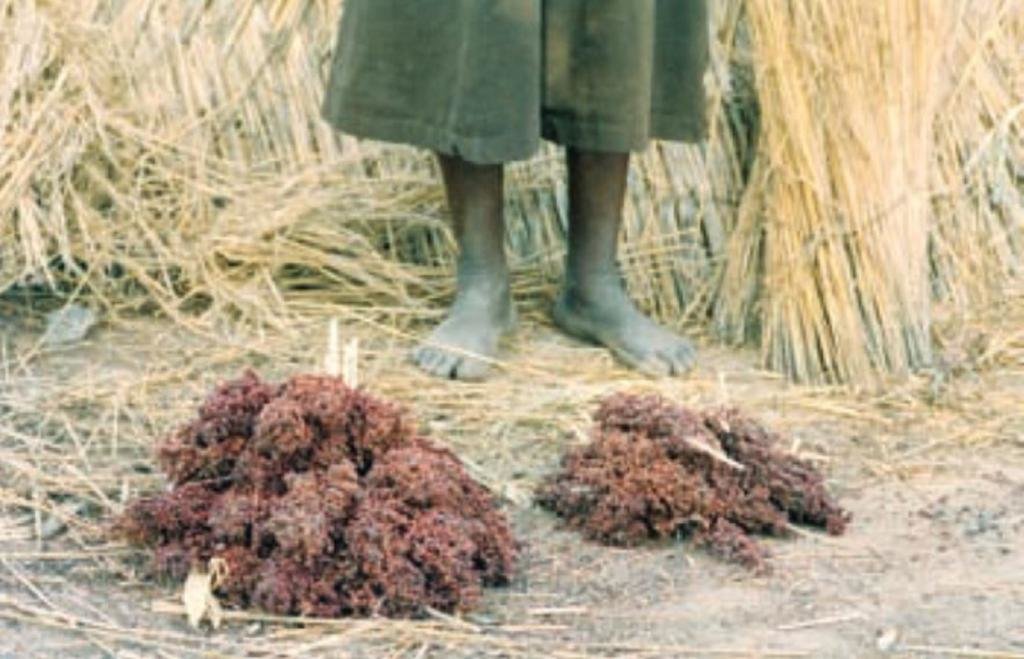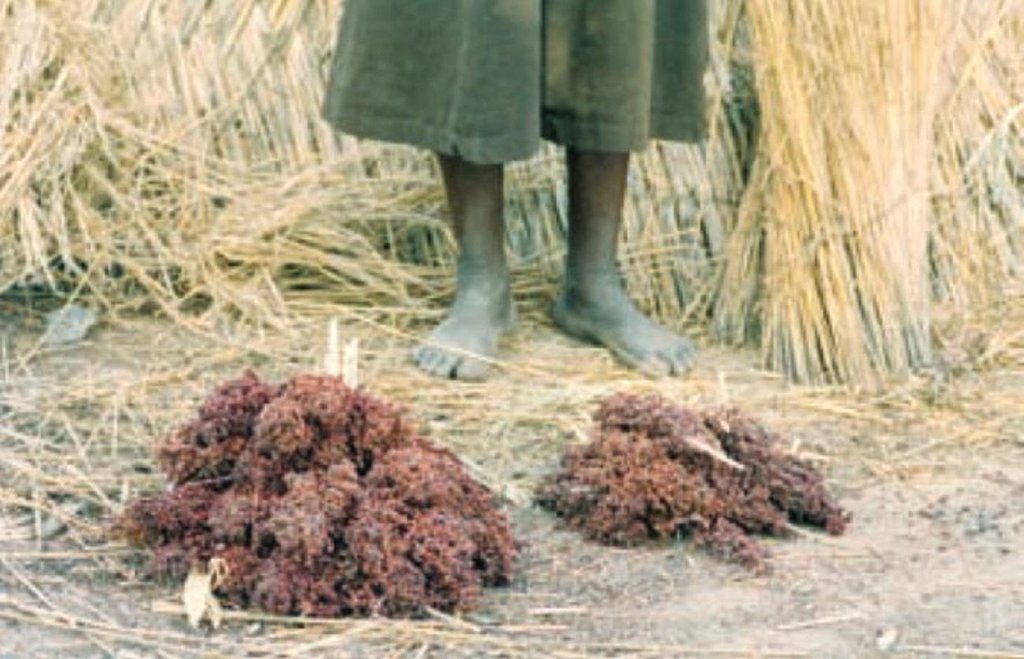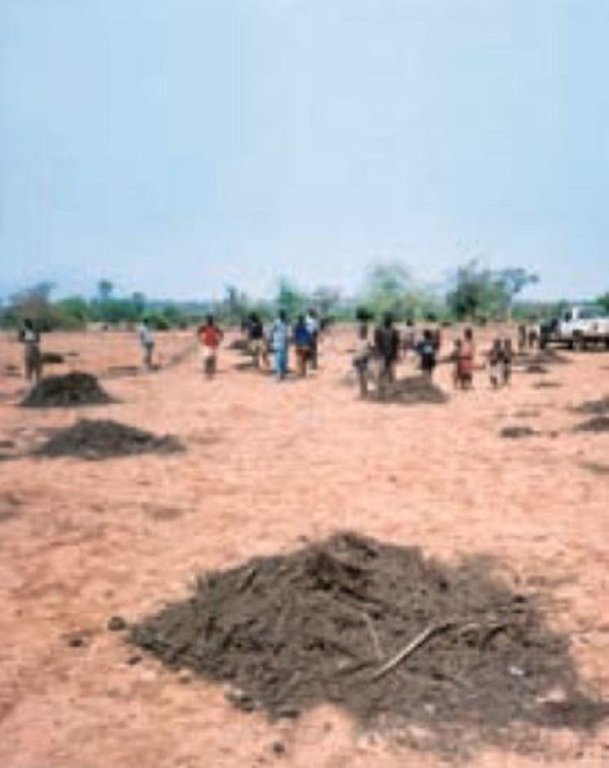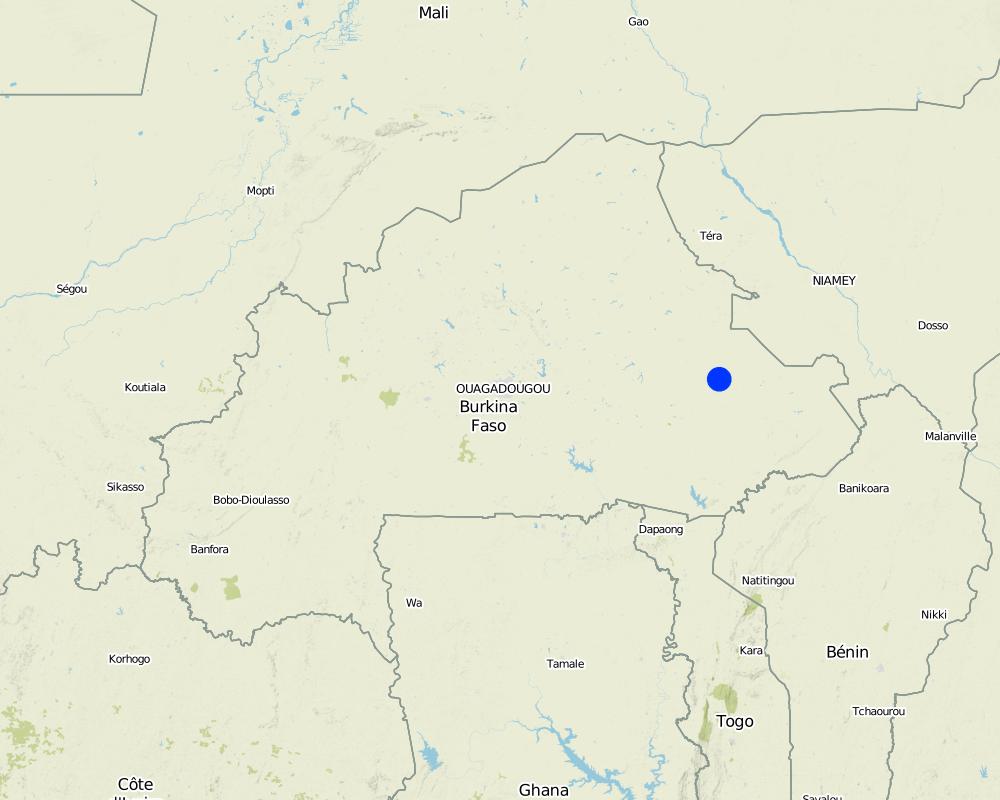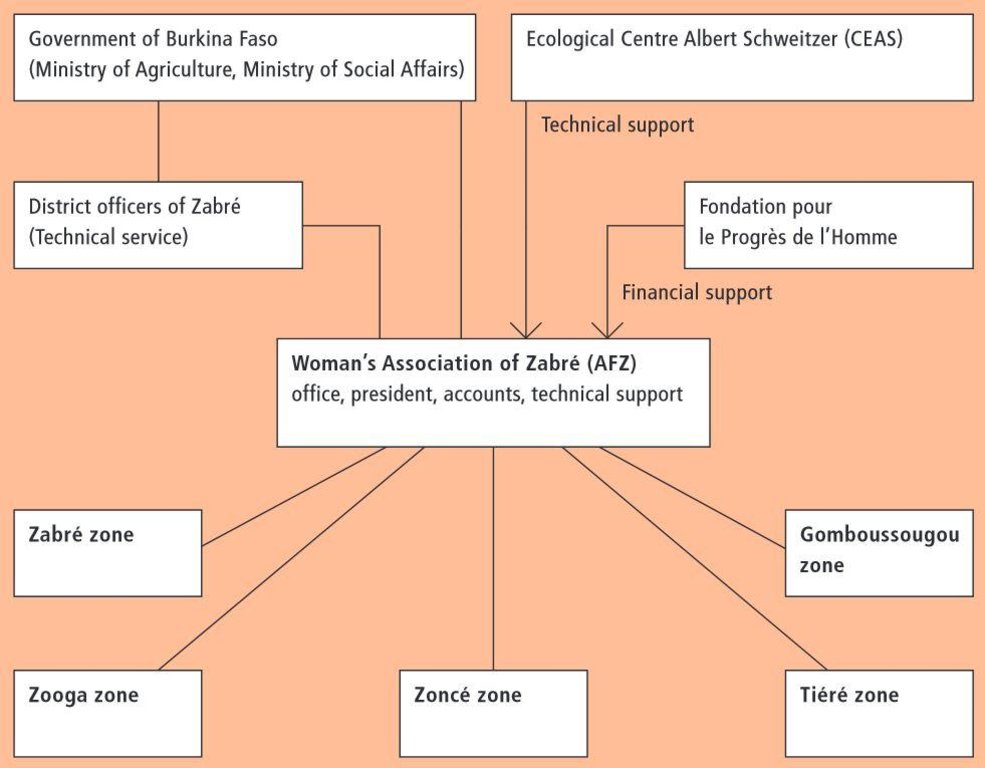Zabré women’s agroecological programme [Burkina Faso]
- Creación:
- Actualización:
- Compilador: Unknown User
- Editor: –
- Revisores: David Streiff, Deborah Niggli
approaches_2405 - Burkina Faso
Visualizar secciones
Expandir todo Colapsar todos1. Información general
1.2 Detalles de contacto de las personas de referencia e instituciones involucradas en la evaluación y la documentación del Enfoque
Persona(s) de referencia clave/s
Especialista MST:
Lougue Maria
Association des femmes Pag-La-Yiri de Zabré (AFZ)
O9 B.P. 335 Ouagadougou 09,
Especialista MST:
De Pury Jean Pascal Etienne
ceas.ne@bluewin.ch / ceas-rb@fasonet.bf
ancien directeur du Centre Ecologique Albert Schweitzer
CH-2000 NeuchâFtel, Switzerland, 2 rue de la Côte,
Suiza
Nombre del proyecto que facilitó la documentación/ evaluación del Enfoque (si fuera relevante)
Book project: where the land is greener - Case Studies and Analysis of Soil and Water Conservation Initiatives Worldwide (where the land is greener)Nombre de la(s) institución(es) que facilitaron la documentación/ evaluación del Enfoque si fuera relevante)
Centre Ecologique Albert Schweitzer (CEAS) - Suiza1.3 Condiciones referidas al uso de datos documentados mediante WOCAT
El compilador y la/s persona(s) de referencia claves aceptan las condiciones acerca del uso de los datos documentados mediante WOCAT :
Sí
1.4 Referencia/s al/los Cuestionario(s) de Tecnologías MST
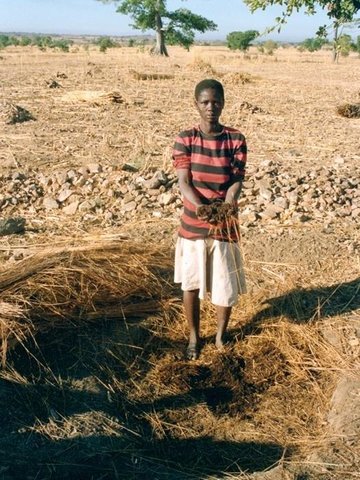
Composting associated with planting pits [Burkina Faso]
Compost production, and its application in planting pits (zai) by farmers on fields near their homes.
- Compilador: Moussa Bonzi
2. Descripción del Enfoque MST
2.1 Breve descripción del Enfoque
A demand-driven initiative, by a women’s association, aimed at the promotion of composting through training and extension, using project staff and local facilitators.
2.2 Descripción detallada del Enfoque MST
Descripción detallada del Enfoque MST:
Aims / objectives: Leaders of the women’s association of Zabré (Association des Femme de Zabré, AFZ) initiated a training programme for their members on compost making, and its application in planting pits (zai) after they visited a seminar on the topic in 1987. AFZ actively sought technical and financial help, and found this through the Centre Ecologique Albert Schweitzer (CEAS, based in Switzerland). Support began with the establishment of a first demonstration site where five local facilitators (one from each zone), learned about and developed the technology together over a whole year - comparing the results with sorghum fields without compost. In the following year, those five facilitators each trained 20 women in their zones, using the same training methods as they themselves had experienced. AFZ set up demonstration and training sites in each of the five zones. These demonstration areas were protected by a wire netting fence, contained a well, a cement water tank, and some shade trees for the compost heaps and training sessions. Machines for the wells, hand tools and manure were fully financed, whereas community infrastructure was only partly funded. Each demonstration site had one hectare of cultivated land, with irrigated vegetables in the dry season and sorghum in the rainy season. The facilitators used this land to demonstrate the effect of the compost, and thus to visually convince the trainees. Each of the trainees carried 20 kg of compost home and applied it to their own sorghum fields. During the first 18 months, a CEAS technician visited the zones regularly.
Methods: In the following years, the neighbouring villages each sent groups of 20 women to the established demonstration and training sites, each group for one day a week. They carried out the successive phases of composting in the demonstration plots, while simultaneously implementing the practice at home - where they were supervised by the facilitators as far as possible. In this way, 500 women were trained within one year. Although it took a while, men gradually began to take part and assist their wives when they lost their fear of being ridiculed by others. Many more women then put themselves forward for training. While waiting, they tried to imitate their neighbours, but with mixed results. The support of the CEAS project decreased over the years until 1997, after which it was phased out, being no longer necessary. Training has since continued through the five zonal facilitators and the local agriculture extension service.
2.3 Fotos del Enfoque
2.5 País/ región/ lugares donde el Enfoque fue aplicado
País:
Burkina Faso
Región/ Estado/ Provincia:
Boulgou Province
Map
×2.6 Fechas de inicio y conclusión del Enfoque
Indique año del inicio:
1987
Año de conclusión (si el Enfoque ya no se aplica):
1997
2.7 Tipo de Enfoque
- proyecto/ basado en un programa
2.8 Propósitos/ objetivos principales del Enfoque
- train 6,000 women members of AFZ (in 1987) in making compost, and applying it to planting pits (zai) in order to double yields of sorghum or maize - the eventual target is for all farmers of the two departments to make, and apply compost on their fields, - improve the status of women and their livelihoods, - encourage women’s participation in development, - promote training and cooperative action
The SLM Approach addressed the following problems: Since the drought and famine periods of 1970-74 and 1981-84, the main concern of the women in Zabré was how to feed their families. This meant trying to raise crop production again to the pre-1970s average of 800 kg/ha from the level of 400 kg/ha to which it had fallen. The soils were deteriorating because of declining organic matter as increased population led to continuous cultivation without fallow periods. The status of women was low, and they found it hard to generate income through other activities.
2.9 Condiciones que facilitan o impiden la implementación de la/s Tecnología/s aplicadas bajo el Enfoque
normas y valores sociales/ culturales/ religiosos
- impiden
Men were afraid of being ridiculed in case of failures.
Treatment through the SLM Approach: Contrastingly, women don’t fear being laughed at. The expectation of increasing the yields encourages them to take risks: eventually men also followed for the same reasons.
disponibilidad/ acceso a recursos y servicios financieros
- impiden
Training of farmers is relatively expensive.
Treatment through the SLM Approach: The donors (Fondation pour le Progrés de l'Homme) and CEAS took care of the approach costs.
entorno institucional
- impiden
The existing institution of the women’s association of Zabré (AFZ), which has functioned well for 12 years, needed to adapt to the new agroecological programme promoted by CEAS.
Treatment through the SLM Approach: The management of the AFZ was motivated to adopt and integrate the technology offered by CEAS.
marco de trabajo legal (tenencia de tierra, derechos de uso de tierra y agua)
- facilitan
Even though the land users do not own the land they cultivate (the state officially owns the land, though land use rights are traditional and secure) they receive immediate and full benefits through improved crop yields.
- impiden
conocimiento de MST, acceso a apoyo técnico
- impiden
One key question was: how best to teach composting to 6,000 women?
Treatment through the SLM Approach: AFZ already had an extension structure and the five facilitators served as ‘multipliers’
3. Participación y roles de las partes interesadas involucradas
3.1 Partes interesadas involucradas en el Enfoque y sus roles
- usuarios locales de tierras/ comunidades locales
There were great differences - in the beginning at least - when AFZ merely asked the men to ‘allow’ their wives to learn about composting. After two years, men started to participate in the training and eventually as many of them as women began to make and use compost. Another difference was in discussions, when men tended to dominate.
- especialistas MST/consejeros agrícolas
- organización internacional
- AFZ
Leaders of the women's association of Zabré
3.2 Involucramiento de los usuarios locales de tierras/ comunidades locales en las distintas fases del Enfoque
| Involucramiento de los usuarios locales de tierras/ comunidades locales | Especifique quién se involucró y describa las actividades | |
|---|---|---|
| iniciación/ motivación | interactivo | discussion of problems in public meetings |
| planificación | interactivo | meetings with those in charge of the groups of women farmers |
| implementación | interactivo | in exchange for the training received, some land users volunteered themselves as temporary/part-time facilitators |
| monitoreo y evaluación | interactivo | the land users learned to control the quality and the efficiency of their work and voluntarily contributed to monitoring/evaluation - the facilitators were responsible for progress reports |
| Research | pasivo | visit of international researchers to the farms |
3.3 Flujograma (si estuviera disponible)
Descripción:
The agroecological programme of the Zabré Women's Association (AFZ). There are five facilitator’s zones each with:
- 1 president, 1 vice-president
- 1 facilitator
- 1 pharmacy
- 1 cereal bank
- 1 meeting room
- 1 shop
- 1 demonstration/training site
3.4 La toma de decisiones en la selección de Tecnología(s) MST
Las decisiones para la selección de la/s Tecnología(s) fueron tomadas:
- Leaders of the women's association of Zabré (AFZ)
Explique:
in consultation with experts from the Centre Ecologique Albert Schweitzer (CEAS).
Decisions on the method of implementing the SLM Technology were made by Leaders of the women's association of Zabré (AFZ). CEAS, their engineers at Zabré and the facilitators designed the approach, which fitted well into the existing structure of AFZ.
4. Apoyo técnico, fortalecimiento institucional y gestión del conocimiento
4.1 Construcción de capacidades / capacitación
¿Se proporcionó la capacitación a usuarios de tierras/ otras partes interesadas?
Sí
Forma de capacitación:
- de agricultor a agricultor
- áreas de demostración
- reuniones públicas
- cursos
Forma de capacitación:
- on-farm training
Temas avanzados:
Training, as the central focus of the approach, was provided on two levels: project staff trained local facilitators, who then further spread the gained SWC knowledge among the land users. Subjects treated included compost making and application, reforestation, soil protection and anti-erosion measures. station training.
4.2 Servicio de asesoría
¿Los usuarios de tierras tienen acceso a un servicio de asesoría?
Sí
Especifique si servicio proporcionado se realizó:
- en los campos de los usuarios de tierras
Describa/ comentarios:
Key elements: demonstrations and practical training of of AFZ’s members in the five demonstrationareas in the respective AFZ zones.
4.3 Fortalecimiento institucional (desarrollo institucional)
¿Se establecieron o fortalecieron instituciones mediante el Enfoque?
- sí, mucho
Especifique el nivel o los niveles en los que se fortalecieron o establecieron las instituciones:
- local
Especifique el tipo de apoyo:
- financiero
- construcción de capacidades/ entrenamiento
- equipo
4.4 Monitoreo y evaluación
¿El monitoreo y la evaluación forman parte del Enfoque?
Sí
Comentarios:
bio-physical aspects were regular monitored by 0 through observations; indicators: colour, texture and temperature of compost
technical aspects were regular monitored by 0 through observations; indicators: learning progress and production
socio-cultural aspects were ad hoc monitored by 0 through observations; indicators: effects on input and product prices
economic / production aspects were regular monitored by 0 through measurements; indicators: agricultural output
area treated aspects were regular monitored by 0 through observations; indicators: fields with compost
no. of land users involved aspects were regular monitored by 0 through observations; indicators: trained land users and implementers of technology
management of Approach aspects were regular monitored by 0 through measurements; indicators: CEAS' accounting expertise
There were no changes in the Approach as a result of monitoring and evaluation
4.5 Investigación
¿La investigación formó parte del Enfoque?
Sí
Proporcione detalles adicionales e indique quién hizo la investigación:
Applied research was not part of this approach. However CEAS used previous recommendations from an applied research station in Gorom (Burkina Faso) and thereby adapted the technology to the local situation.
5. Financiamiento y apoyo material externo
5.1 Presupuesto anual para el componente MST del Enfoque
Comentarios (ej. fuentes principales de financiamiento/ donantes principales):
Approach costs were met by the following donors: international (CEAS&Fondation pour le progrés del'homme): 80.0%; government (national): 20.0%
5.2 Apoyo financiero/material proporcionado a los usuarios de tierras
¿Los usuarios de tierras recibieron financiamiento/ apoyo material para implementar la Tecnología/ Tecnologías? :
Sí
5.3 Subsidios para insumos específicos (incluyendo mano de obra)
- equipo
| Especifique qué insumos se subsidiaron | En qué grado | Especifique los subsidios |
|---|---|---|
| maquinaria | totalmente financiado | machines for the wells on demonstration areas |
| herramientas | totalmente financiado | |
- agrícola
| Especifique qué insumos se subsidiaron | En qué grado | Especifique los subsidios |
|---|---|---|
| manure | totalmente financiado | |
- infraestructura
| Especifique qué insumos se subsidiaron | En qué grado | Especifique los subsidios |
|---|---|---|
| ommunity infrastructure | totalmente financiado | |
Si la mano de obra de usuarios de tierras fue un insumo sustancial, ¿fue:
- voluntario?
Comentarios:
the hope of increasing yields served as an effective incentive.
5.4 Crédito
¿Se proporcionó crédito bajo el Enfoque para actividades MST?
No
6. Análisis de impacto y comentarios de conclusión
6.1 Impactos del Enfoque
¿El Enfoque ayudó a los usuarios de tierras a implementar y mantener Tecnologías MST?
- No
- Sí, un poco
- Sí, moderadamente
- Sí, mucho
The compost making and its application has helped to improve soil and water management, as the compost returns humus to the soil and increases its water retention capacity and thus improves ground cover.
Did other land users / projects adopt the Approach?
- No
- Sí, un poco
- Sí, moderadamente
- Sí, mucho
Many women's groups from other regions throughout the country invite delegations from AFZ to teach them compost making. The AFZ delegates are provided with food, accommodation, travel costs and presents in exchange for training. This is much cheaper than the 'official' compost training provided by the Association for Agroecological Technology Development (ADTAE).
6.3 Sostenibilidad de las actividades del Enfoque
¿Pueden los usuarios de tierras sostener lo que se implementó mediante el Enfoque (sin apoyo externo)?
- sí
Si respondió que sí, describa cómo:
The land users are continuing activities and can do so in future, assuming no new problems arise.
6.4 Fortalezas/ ventajas del Enfoque
| Fuerzas/ ventajas/ oportunidades desde la perspectiva del compilador o de otra persona de referencia clave |
|---|
| Land users have confidence in their organisation (AFZ) and learn while working in the fields and discussing with the facilitators (How to sustain/ enhance this strength: The facilitators know to nurture this confidence until the land users get profit from the compost (which in turn reinforces that confidence).) |
| AFZ was convinced about the necessity of compost before they knew about CEAS. They searched for a technical collaborator for training and financial support (How to sustain/ enhance this strength: This preliminary motivation is an asset and the technical partner has to fulfil neither less, nor more, than what AFZ expects.) |
| Training of local trainers/facilitators (How to sustain/ enhance this strength: Positive feedback from the farmers will stimulate the facilitators to continue their work.) |
| AFZ represents female land users, it is local and not 'created' by CEAS and is thus an ideal structure (How to sustain/ enhance this strength: CEAS has the knowledge, but AFZ has the power. AFZ needs to learn to use its power to access CEAS' knowledge bank.) |
6.5 Debilidades/ desventajas del Enfoque y formas de sobreponerse a ellos
| Debilidades/ desventajas/ riesgos desde la perspectiva del compilador o de otra persona de referencia clave | ¿Cómo sobreponerse a ellas? |
|---|---|
| Internal conflicts within the association may cause problems and there is a danger of CEAS specialists becoming involved in these AFZ rivalries | CEAS should be aware of AFZ power struggles and not get involved. CEAS must stick to its technical role - which is related to knowledge only and not to power. |
7. Referencias y vínculos
7.1 Métodos/ fuentes de información
- visitas de campo, encuestas de campo
- entrevistas con usuarios de tierras
7.2 Referencias a publicaciones disponibles
Título, autor, año, ISBN:
UNEP (2002) Enriching soils naturally. In: Success stories in the struggle against desertification pp 5-8
Título, autor, año, ISBN:
UNEP (2002) Enriching soils naturally. In: Success stories in the struggle against desertification pp 5-8
Vínculos y módulos
Expandir todo Colapsar todosVínculos

Composting associated with planting pits [Burkina Faso]
Compost production, and its application in planting pits (zai) by farmers on fields near their homes.
- Compilador: Moussa Bonzi
Módulos
No se hallaron módulos



